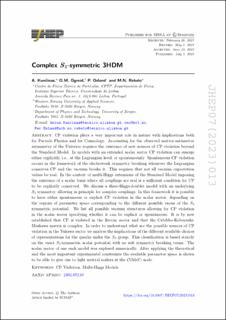| dc.contributor.author | Kunčinas, A. | |
| dc.contributor.author | Øgreid, Odd Magne | |
| dc.contributor.author | Osland, Per | |
| dc.contributor.author | Rebelo, M.N. | |
| dc.date.accessioned | 2023-09-18T13:33:56Z | |
| dc.date.available | 2023-09-18T13:33:56Z | |
| dc.date.created | 2023-08-31T10:12:59Z | |
| dc.date.issued | 2023 | |
| dc.identifier.citation | Journal of High Energy Physics (JHEP). 2023, 2023 (7), . | en_US |
| dc.identifier.issn | 1126-6708 | |
| dc.identifier.uri | https://hdl.handle.net/11250/3090158 | |
| dc.description.abstract | CP violation plays a very important role in nature with implications both for Particle Physics and for Cosmology. Accounting for the observed matter-antimatter asymmetry of the Universe requires the existence of new sources of CP violation beyond the Standard Model. In models with an extended scalar sector CP violation can emerge either explicitly, i.e., at the Lagrangian level, or spontaneously. Spontaneous CP violation occurs in the framework of the electroweak symmetry breaking whenever the Lagrangian conserves CP and the vacuum breaks it. This requires that not all vacuum expectation values be real. In the context of multi-Higgs extensions of the Standard Model imposing the existence of a scalar basis where all couplings are real is a sufficient condition for CP to be explicitly conserved. We discuss a three-Higgs-doublet model with an underlying S3 symmetry, allowing in principle for complex couplings. In this framework it is possible to have either spontaneous or explicit CP violation in the scalar sector, depending on the regions of parameter space corresponding to the different possible vacua of the S3 symmetric potential. We list all possible vacuum structures allowing for CP violation in the scalar sector specifying whether it can be explicit or spontaneous. It is by now established that CP is violated in the flavour sector and that the Cabibbo-KobayashiMaskawa matrix is complex. In order to understand what are the possible sources of CP violation in the Yukawa sector we analyse the implications of the different available choices of representations for the quarks under the S3 group. This classification is based strictly on the exact S3-symmetric scalar potential with no soft symmetry breaking terms. The scalar sector of one such model was explored numerically. After applying the theoretical and the most important experimental constraints the available parameter space is shown to be able to give rise to light neutral scalars at the O(MeV) scale. | en_US |
| dc.language.iso | eng | en_US |
| dc.publisher | Springer | en_US |
| dc.rights | Navngivelse 4.0 Internasjonal | * |
| dc.rights.uri | http://creativecommons.org/licenses/by/4.0/deed.no | * |
| dc.title | Complex S <inf>3</inf>-symmetric 3HDM | en_US |
| dc.title.alternative | Complex S <inf>3</inf>-symmetric 3HDM | en_US |
| dc.type | Peer reviewed | en_US |
| dc.type | Journal article | en_US |
| dc.description.version | publishedVersion | en_US |
| dc.rights.holder | © The Authors | en_US |
| dc.source.pagenumber | 44 | en_US |
| dc.source.volume | 2023 | en_US |
| dc.source.journal | Journal of High Energy Physics (JHEP) | en_US |
| dc.source.issue | 7 | en_US |
| dc.identifier.doi | 10.1007/JHEP07(2023)013 | |
| dc.identifier.cristin | 2171273 | |
| cristin.ispublished | true | |
| cristin.fulltext | original | |
| cristin.qualitycode | 2 | |

